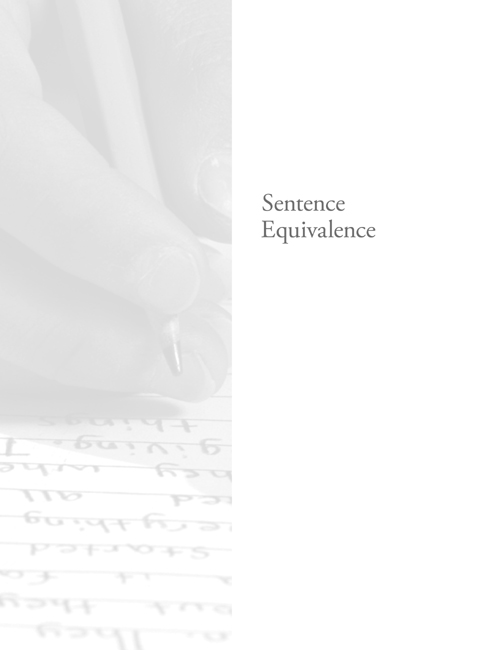
The directions for Sentence Equivalence state: Select the two answer choices that, when used to complete the sentence, fit the meaning of the sentence as a whole and produce completed sentences that are alike in meaning.
In other words, figure out the story being told and pick the two words in the answer choices that complete the story in the same way. These are like Sentence Completion questions you might remember from the SAT or previous versions of the GRE, but you are picking two words rather than one for the same blank.
A word of warning on Sentence Equivalence: Beware of the answer choices. They will always fit grammatically into the sentence, and most of them will sound pretty attractive. Just remember that the answer choices represent ETS’s “suggestions” for what to put in the blank. We don’t like ETS’s suggestions, we don’t trust ETS’s suggestions, and we don’t want ETS’s suggestions. The answer choices have been carefully selected and then tested on thousands of students for the sole purpose of messing with your head. The first step on Sentence Equivalence is always to cover up the answer choices. Literally put your hand on the screen, and don’t let them pollute your thinking.
Think of the sentence itself as a mini Reading Comprehension passage. Before you do anything, find the main idea. Who is the passage talking about? What are we told about this person or thing? Once you have the story firmly in mind, come up with your own word for the blank, and eliminate the answer choices that don’t match.
Step 1—Cover the answer choices.
Step 2—Find the story. Who is our main character? What are we told about the main character?
Step 3—Come up with your own word for the blank. Don’t look at the answer choices. Force yourself to come up with your own word based upon the information in the passage.
Step 4—Process of Elimination (POE). Use your word to eliminate answer choices. Look at each answer choice and ask whether it matches your word. If not, get rid of it. If the answer is “I’m not sure,” give it the maybe and move on. If the answer is yes, give it the check. Make sure that all of this work takes place on your scratch paper.
The “Clue” is that part of the sentence that tells you what to put in the blank. Every sentence must have one because it’s the part of the sentence that tells you whether an answer choice is right or wrong. The clue is like an arrow that points only to right answers. Finding the clue is the key to coming up with your own word and eliminating wrong answers!
Imagine a conversation that begins, “That’s Frank. He won the lottery and now ________.” Something good is going to go into that blank. Frank could be a millionaire, could be living on his own island, or could be a great collector of rare jeweled belt buckles. Whatever it is, this story is going to end happily.
Now consider this story: “That’s Frank. He won the lottery but now _________.” This story is going to end badly. Frank could be tied up in court for tax evasion, panhandling on the corner, or in a mental institution.
The only difference between these two stories are the words but and and. These are triggers. Here are some of the triggers that show up on the GRE most frequently.
|
but |
in contrast |
|
although (though, even though) |
unfortunately |
|
unless |
heretofore |
|
rather |
thus |
|
yet |
and |
|
despite |
therefore |
|
while |
similarly |
|
however |
; or : |
When it comes to Sentence Equivalence, remember these three things: